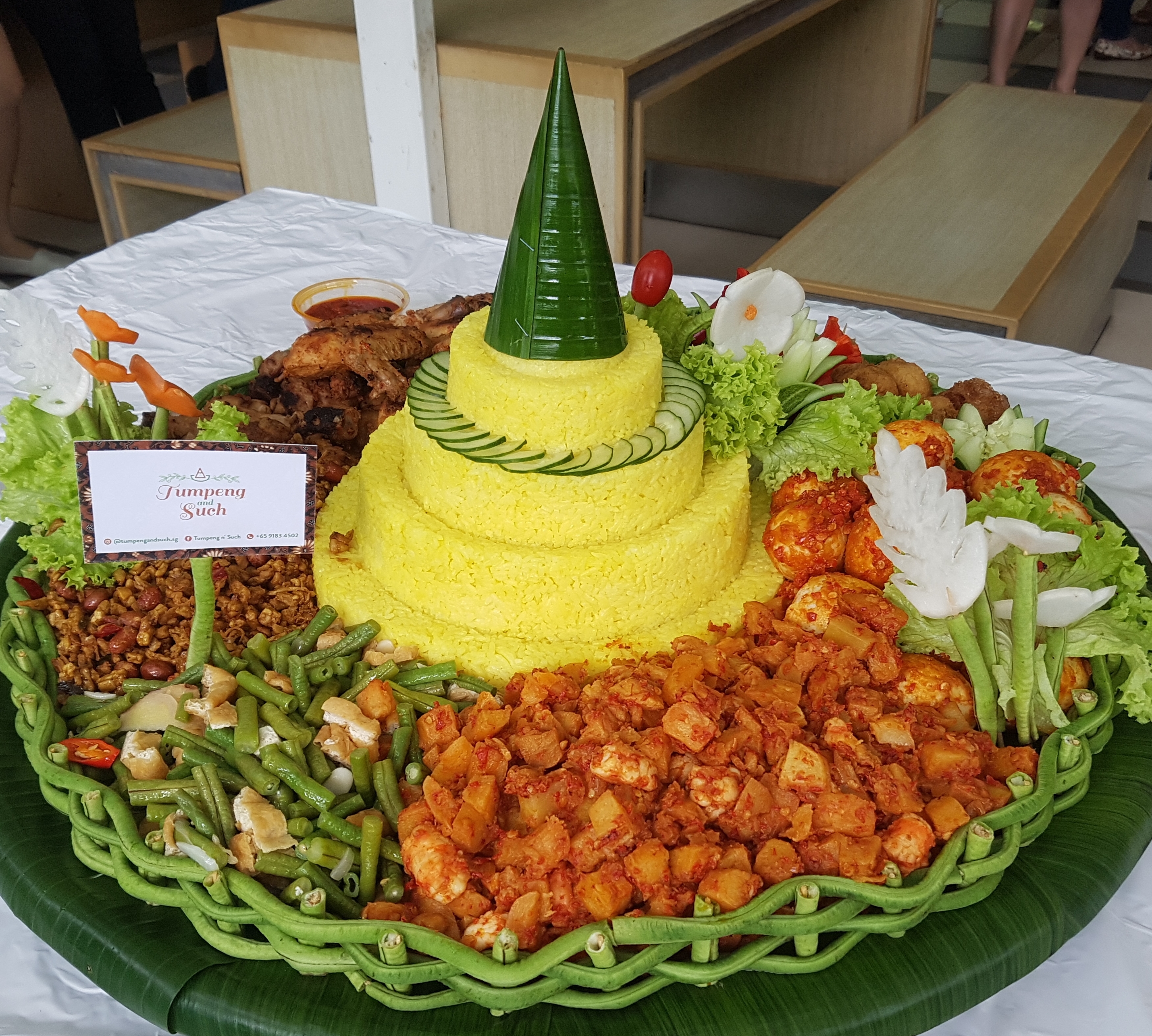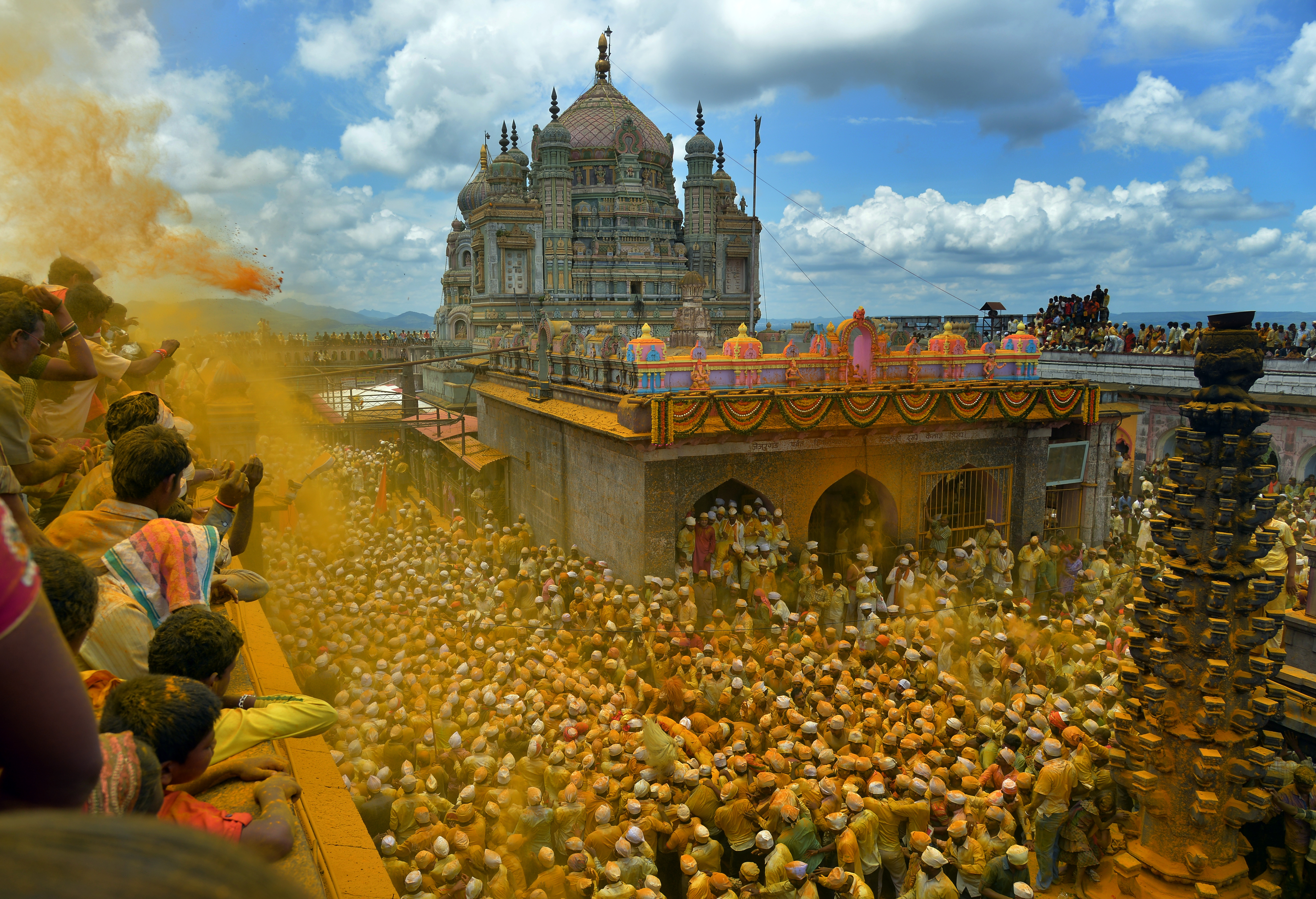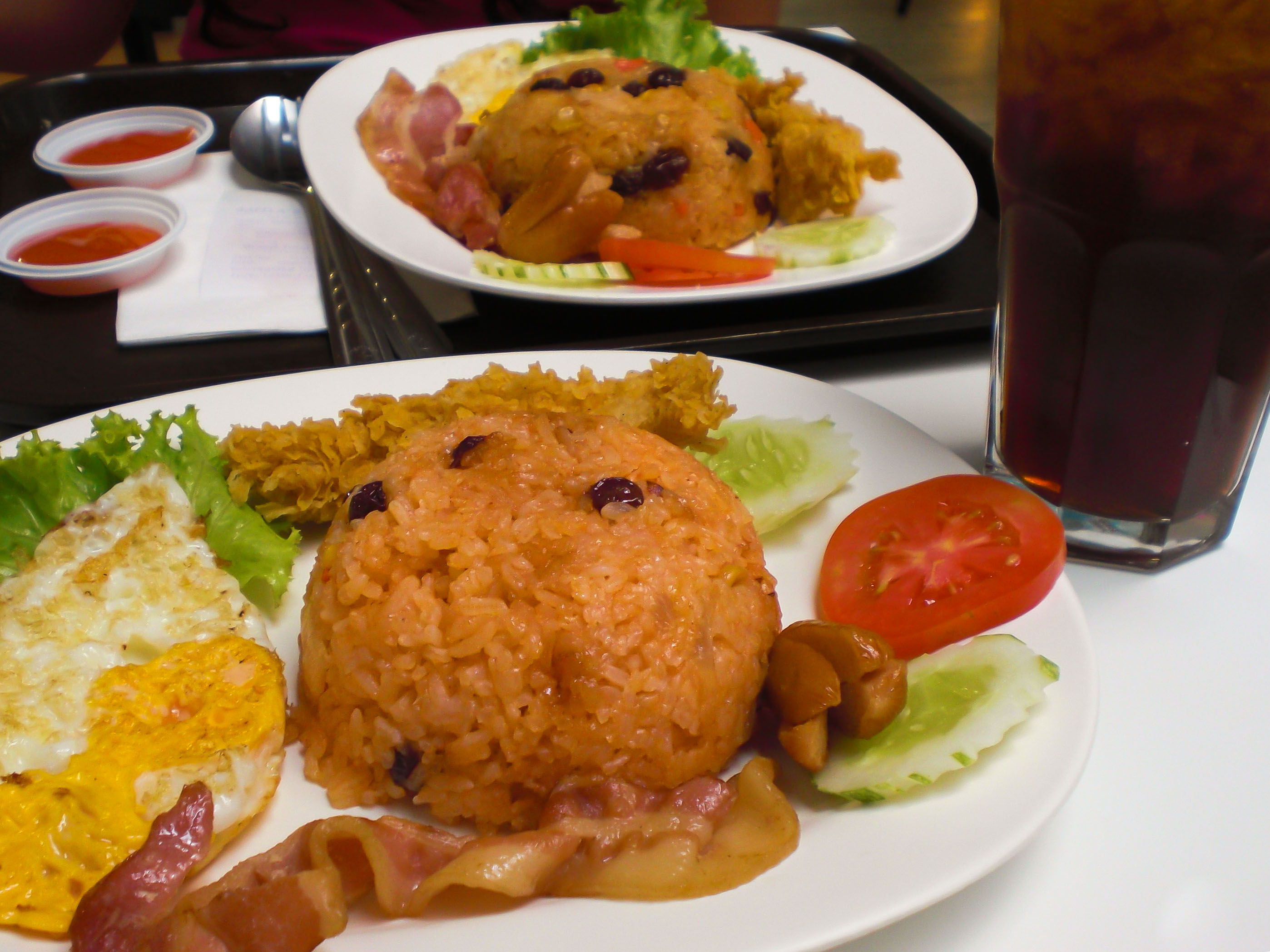|
Nasi Kuning
''Nasi kuning'' (literally, "yellow rice"; ), or sometimes called ''nasi kunyit'' (literally, "turmeric rice"; ), is an Indonesian fragrant rice dish cooked with coconut milk and turmeric, hence the name ''nasi kuning'' (yellow rice). ''Nasi kuning'' also can be found in neighbouring Malaysia, Brunei, Singapore and Cocos Island, Australia. Because of its perceived favourable fortune and auspicious meaning, ''nasi kuning'' is often served as a special dish for celebrations; e.g. community rituals, ceremonies, birthdays, weddings, anniversaries and also the independence day celebration. Nevertheless, it is also a favourite dish for breakfast in Indonesia. In the Philippines, a related dish exists in Mindanao, particularly among the Maranao people, where it is known as '' kuning''. Like the Indonesian version, it primarily uses turmeric, but also adds lemongrass and does not use coconut milk. A similar dish is also found in Sri Lankan cuisine where it is known as ''kaha buth'' ... [...More Info...] [...Related Items...] OR: [Wikipedia] [Google] [Baidu] |
List Of Indonesian Dishes
This is a list of selected dishes found in Indonesian cuisine. Staple foods Main dishes Curries Meals Soy-based foods Preserved meats Rice dishes and porridges Congees and porridges Rice cake dishes Rice dishes Noodle dishes Soups and stews Salads and vegetable dishes Breads and sandwiches Snacks and starters Savoury snacks Sweet snacks Crackers, chips, and crisps Sweet desserts Cheeses Beverages Seasonings and condiments Common ingredients Spices * Anise (''Adas Manis'') * Asam kandis (dried fruit of ''Garcinia xanthochymus'') * Asam sunti (dried fruit of ''Averrhoa bilimbi'') * Candlenuts (''Kemiri'') * Cardamom (''Kapulaga'') * Chili (''Cabai'') * Cinnamon (''Kayu Manis'') * Clove (Cengkeh) * Coriander seeds (''Ketumbar'') * Cumin seeds (''Jinten'') * Fennel (''Adas'') * Fenugreek (Klabet) * Fingerroot (''Temu Kunci'') * Galangal (''Lengkuas'') * Garcinia atroviridis (''Asam Gelugur'') * Garlic (Bawang putih ... [...More Info...] [...Related Items...] OR: [Wikipedia] [Google] [Baidu] |
Turmeric
Turmeric (), or ''Curcuma longa'' (), is a flowering plant in the ginger family Zingiberaceae. It is a perennial, rhizomatous, herbaceous plant native to the Indian subcontinent and Southeast Asia that requires temperatures between and high annual rainfall to thrive. Plants are gathered each year for their rhizomes, some for propagation in the following season and some for consumption or dyeing. The rhizomes can be used fresh, but they are often boiled in water and dried, after which they are ground into a deep orange-yellow shelf-stable spice powder commonly used as a coloring and flavoring agent in many Asian cuisines, especially for curries ( curry powder). Turmeric powder has a warm, bitter, black pepper-like flavor and earthy, mustard-like aroma. Although long used in Ayurvedic medicine, there is no high-quality clinical evidence that consuming turmeric or the principal turmeric constituent, curcumin, is effective for treating any disease. Curcumin, a bright ye ... [...More Info...] [...Related Items...] OR: [Wikipedia] [Google] [Baidu] |
Kuning
''Kuning'', also spelled ''koning'', ''kyuning'', or ''kiyuning'' and Anglicized as yellow rice or turmeric rice, is a Filipino rice dish cooked with turmeric, lemongrass, salt, bay leaves, and other spices to taste. It originates from the island of Mindanao and is a staple food among the Maranao people of Lanao del Sur. It is related to the Indonesian ''nasi kuning'' of neighboring Sulawesi, but it does not use coconut milk. The dish is characteristically yellow because of the use of turmeric (''kalawag'' in Maranao, and ''kunig'' or ''luyang dilaw'' in most other Philippine languages). See also * Bringhe * Java rice * Palapa * Sinigapuna ''Sinigapuna'' is a Filipino rice dish cooked with turmeric and other spices. It originates from Kalagan (or Caragan) people of the Caraga and Davao Regions of Mindanao. It is similar to the Maranao '' kuning'', and Indonesian ''nasi kuning' ... * Sinangag References {{Filipino food Philippine rice dishes ... [...More Info...] [...Related Items...] OR: [Wikipedia] [Google] [Baidu] |
Maranao People
The Maranao people (Maranao language, Maranao: ''Bangsa'' ''Mëranaw''; Filipino language, Filipino: ''mga'' ''Maranaw''), also spelled Meranaw, Maranaw, and Mëranaw, is a predominantly Muslim Filipino people, Filipino ethnic groups of the Philippines, ethnic group native to the region around Lanao Lake in the island of Mindanao. They are known for their artwork, weaving, wood, plastic and metal crafts and epic literature, the Darangen. They are ethnically and culturally closely related to the Iranun people and Maguindanao people, all three groups being denoted speaking Danao languages and giving name to the island of Mindanao. They are grouped with other Moro people due to their shared religion. Etymology The name "Maranao" (also spelled "Mëranaw", or "Maranaw") means "people of the lake" (''lanaw'' or ''ranaw'', Archaism, archaic ''danaw'', means "lake" in the Maranao language). This is in reference to Lake Lanao, the predominant geographic feature of the ancestral hom ... [...More Info...] [...Related Items...] OR: [Wikipedia] [Google] [Baidu] |
Breakfast
Breakfast is the first meal of the day usually eaten in the morning. The word in English refers to breaking the fasting period of the previous night. Various "typical" or "traditional" breakfast menus exist, with food choices varying by regions and traditions worldwide. History In Old English, a regular morning meal was called , and the word ''dinner'', which originated from Gallo-Romance ''desjunare'' ("to break one's fast"), referred to a meal after fasting. Around the mid-13th century, that meaning of ''dinner'' faded away, and around the 15th century "breakfast" came into use in written English to describe a morning meal. Anderson, p. 5 Ancient breakfast Ancient Egypt In Ancient Egypt, peasants ate a daily meal, most likely in the morning, consisting of soup, beer, bread, and onions before they left for work in the fields or work commanded by the pharaohs. The traditional breakfast believed to have been cooked in ancient Egypt was fūl (made from fava beans, possib ... [...More Info...] [...Related Items...] OR: [Wikipedia] [Google] [Baidu] |
Independence Day (Indonesia)
The Independence Day of Indonesia (in bahasa Indonesia, Indonesian formally known as ''Hari Ulang Tahun Kemerdekaan Republik Indonesia'' shortened "HUT RI", or simply Hari Kemerdekaan, and colloquially referred by the people as ''Tujuhbelasan'', meaning "the Seventeenth") is a Public holidays in Indonesia, national holiday in Indonesia commemorating the anniversary of Proclamation of Indonesian Independence, Indonesia's proclamation of independence on 17 August 1945. It was made a national holiday by government decree in 1946. Ceremonies and festivities are held throughout the country to celebrate this national day, including the flag hoisting ceremony conducted nation-wide and at Indonesian diplomatic installations abroad, local community competitions, with patriotic and cultural parades. Discounts are offered by participating shopping centres or businesses. On 16 August or the last Friday prior to 17 August, the president of Indonesia addresses the nation at the People's Cons ... [...More Info...] [...Related Items...] OR: [Wikipedia] [Google] [Baidu] |
Kompas
''Kompas'' () is an Indonesian national newspaper published in Jakarta, founded on 28 June 1965. It is published by PT Kompas Media Nusantara, which is part of Kompas Gramedia Group. The paper's head office is located at the Kompas Multimedia Towers, Tanah Abang, Central Jakarta. It is considered Indonesia's newspaper of record. The paper manages an online portal, kompas.id, which contains updated news and the digital subscription version of the paper, while Kompas Gramedia also manages another editorially separated portal, kompas.com. ''Kompas'' is one of two newspapers in Indonesia audited by the International Federation of Audit Bureau of Circulations. History General Ahmad Yani, then commander of the Indonesian Army, first suggested the paper to Frans Seda, a government minister and leader of the Catholic Party. Yani encouraged Seda to publish a newspaper representative of the Catholic Party faction to counter the communist propaganda spearheaded by the PKI. Se ... [...More Info...] [...Related Items...] OR: [Wikipedia] [Google] [Baidu] |
Australia
Australia, officially the Commonwealth of Australia, is a country comprising mainland Australia, the mainland of the Australia (continent), Australian continent, the island of Tasmania and list of islands of Australia, numerous smaller islands. It has a total area of , making it the list of countries and dependencies by area, sixth-largest country in the world and the largest in Oceania. Australia is the world's flattest and driest inhabited continent. It is a megadiverse countries, megadiverse country, and its size gives it a wide variety of landscapes and Climate of Australia, climates including deserts of Australia, deserts in the Outback, interior and forests of Australia, tropical rainforests along the Eastern states of Australia, coast. The ancestors of Aboriginal Australians began arriving from south-east Asia 50,000 to 65,000 years ago, during the Last Glacial Period, last glacial period. By the time of British settlement, Aboriginal Australians spoke 250 distinct l ... [...More Info...] [...Related Items...] OR: [Wikipedia] [Google] [Baidu] |
Cocos (Keeling) Islands
The Cocos (Keeling) Islands (), officially the Territory of Cocos (Keeling) Islands (; ), are an Australian external territory in the Indian Ocean, comprising a small archipelago approximately midway between Australia and Sri Lanka and relatively close to the Indonesian island of Sumatra. The territory's dual name (official since the islands' incorporation into Australia in 1955) reflects that the islands have historically been known as either the Cocos Islands or the Keeling Islands. The territory consists of two atolls made up of 27 coral islands, of which only two – West Island and Home Island – are inhabited. The population of around 600 people consists mainly of Cocos Malays, who mostly practise Sunni Islam and speak a dialect of Malay as their first language. The territory is administered by the Australian federal government's Department of Infrastructure, Transport, Regional Development, Communications and the Arts as an Australian external territory and t ... [...More Info...] [...Related Items...] OR: [Wikipedia] [Google] [Baidu] |
Malaysian Cuisine
Malaysian cuisine (Malay language, Malay: ''Masakan Malaysia''; Jawi script, Jawi: ) consists of cooking traditions and practices found in Malaysia, and reflects the multi-ethnic makeup of its population. The vast majority of Malaysia's population can roughly be divided among three major ethnic groups: Ethnic Malays, Malays, Chinese Malaysian, Chinese and Indian Malaysian, Indians. The remainder consists of the Dayak people, indigenous peoples of Sabah and Sarawak in East Malaysia, the Orang Asli of Peninsular Malaysia, the Peranakan and Eurasian creole communities, as well as a significant number of foreign workers and expatriates. As a result of historical migrations, colonisation by foreign powers, and its geographical position within its wider home region, Malaysia's culinary style in the present day is primarily a melange of traditions from its Malay, Chinese, Indian, Indonesian cuisine, Indonesian, Thai, Filipino cuisine, Filipino and indigenous Bornean and Orang Asli, w ... [...More Info...] [...Related Items...] OR: [Wikipedia] [Google] [Baidu] |
Coconut Milk
Coconut milk is a plant milk extracted from the grated pulp of mature coconuts. The opacity and rich taste of the milky-white liquid are due to its high oil content, most of which is saturated fat. Coconut milk is a traditional food ingredient used in Southeast Asia, Oceania, South Asia, and East Africa. It is also used for cooking in the Caribbean, Central America, northern parts of South America and West Africa, where coconuts were introduced during the colonial era. Coconut milk is differentiated into subtypes based on fat content. They can be generalized into coconut cream (or thick coconut milk) with the highest amount of fat; coconut milk (or thin coconut milk) with a maximum of around 20% fat; and coconut skim milk with negligible amounts of fat. This terminology is not always followed in commercial coconut milk sold in Western countries. Coconut milk can also be used to produce milk substitutes (differentiated as "coconut milk beverages"). These products are not ... [...More Info...] [...Related Items...] OR: [Wikipedia] [Google] [Baidu] |
Rice Dish
This is a list of rice dishes from all over the world, arranged alphabetically. Rice is the seed of the monocot plants ''Oryza sativa'' (Asian rice) or ''Oryza glaberrima'' (African rice). As a cereal, cereal grain, it is the most widely consumed staple food for a large part of the world's human population, especially in Asia and the West Indies. It is the grain with the second-highest worldwide production, after maize (corn), according to data for 2010. List by country Unsorted * Aiwowo * Bagoong fried rice * Buttered rice * Insalata di riso * Kanika (food), Kanika * KFC rice * Lentil rice * Mutabbaq samak * Sayadieh See also * Arabic rice – a pilaf preparation using rice and vermicelli noodles * List of fried rice dishes * List of rice beverages * List of rice varieties * List of tortilla-based dishes * Pakistani rice dishes References {{Lists of prepared foods Rice dishes, * Lists of foods by type, Rice dishes Korean cuisine-related lists, Rice dishes World cuisin ... [...More Info...] [...Related Items...] OR: [Wikipedia] [Google] [Baidu] |








